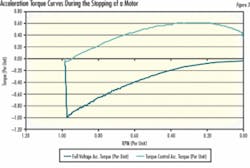Soft-Start Controller with Torque Control Can Reduce Water Hammer, Maintenance Costs
Water hammer is a common topic of concern in water and wastewater treatment plant pumping applications. This phenomenon occurs due to pressure transients in pipelines that are most often caused by the rapid opening and closing of valves and cycling of pumps. Due to a loss of pressure during the cycling of a pump, check valves can close at a rate that causes water hammer in the system and can cause premature valve wear, ultimately increasing maintenance and replacement costs for plant operators.
One method for reducing the severity of water hammer during pump cycling is the use of a torque-controlled soft-start controller for the pump motor. Using this type of controller creates a linear ramping of the motor torque during starting and stopping.
Traditional motor starting methods require a sudden change in the acceleration torque of a motor as the motor reaches operational speed or shuts down. This sudden change in acceleration torque can cause a sudden change in fluid velocity. Maintaining a linear ramping of the motor torque during pump startup and shutdown will result in a smooth acceleration or deceleration of the fluid flow, thus reducing the frequency of occurrence and severity of water hammer during pump cycling.
Figure 1 shows typical speed-torque curves for a pump motor using full voltage or “across-the-line” starting. The “Motor Torque” curve is the torque produced by the motor. The “Load Torque” curve is the torque required by the load, in this case a centrifugal pump, to maintain a given speed and the “Acceleration Torque” curve is the difference between the two.
The intersection of the “Motor Torque” curve with the “Load Torque” curve is the steady state operating point of the motor-pump system. The rapid change in torque at the end of the start cycle or shutdown cycle can produce a rapid change in fluid velocity and pressure, which creates water hammer.
Figure 2 compares the accelerating torque of a full voltage starter, a soft start controller using a linear voltage ramp, and a soft starter using a torque control method. The figure shows that the accelerating torque of the voltage controlled soft starter and the full voltage starter are identical at the end of the starting process.
The torque-controlled starter provides an acceleration that is smoother than that produced by either the full voltage starter or conventional linear voltage ramp soft starter.
Using torque control during the stopping of pumps will provide the operator much better control of the fluid flow. Typical soft starts are unable to maintain a smooth deceleration because once the motor torque reaches 60-80% of the steady-state value the change in speed from the beginning of the process to the end of the process is small. As the voltage ramp of the voltage soft starter reaches 30-50% of the voltage ramping time limit, the motor torque drops off rapidly, thus producing an abrupt stopping of the motor. This abrupt stopping will cause check valves to close forcefully and quickly, thus producing water hammer.
Figure 3 shows the acceleration torque of a motor that is shut down instantly and the acceleration torque of a motor that is shut down using the linear torque ramping method. The figure shows that in the case of an instant shutdown the accelerating torque instantly goes from zero to a value that is opposite of the load torque. The sudden change makes it impossible to control the fluid velocity.
The accelerating torque of the starter using the torque control method is once again smoother and control of the fluid velocity is possible.
Using a soft starter that maintains smooth changes in fluid velocity and pressure can be very beneficial. For example, the Square D Altistart® 48 family of Soft-Start Controllers feature an exclusive torque control system (TCS) that does not depend upon external speed-sensing devices. The Altistart 48 offers adjustable torque ramping time for motor starting and stopping, as well as adjustable initial starting torque and final deceleration torque, making it an ideal solution for water hammer issues due to pump cycling.
With the right starter, water and wastewater plants can work toward eliminating sudden changes in fluid velocity and pressure. Check valves will be less likely to operate rapidly during the stopping of a motor, and mechanical stresses placed on the drive system will be reduced.
Conventional voltage-ramping soft starters provide many benefits. However, better control of pumping systems can be accomplished by using newer-design torque controlled starters.
About the Author:
James Wallace is a senior applications engineer in Square D’s Power Systems Engineering group. He is responsible for power system studies, design, and monitoring services for Square D customers, as well as engineering support for Square D’s field service operations. He is knowledgeable in power system design, grounding, protection, equipment and power quality. Wallace received a BS degree in mechanical engineering from Auburn University in 1997. He is a member of the Institute of Electrical and Electronics Engineers, and a licensed engineer in the states of Alabama and Mississippi.



